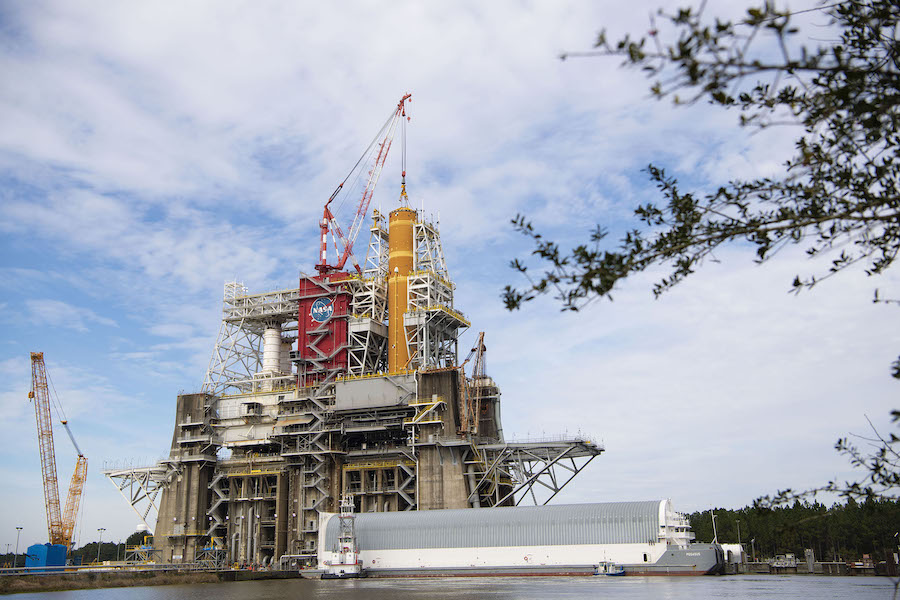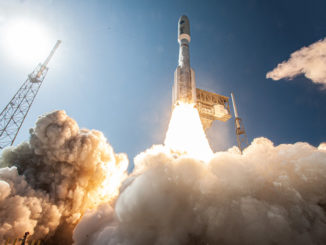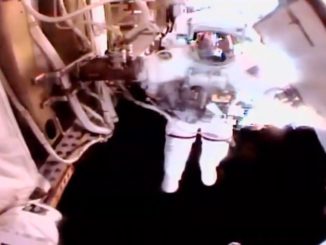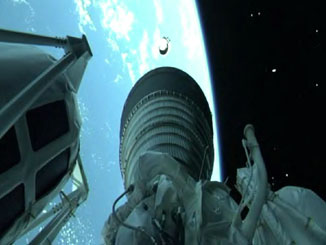
Weeks after leaving its factory in New Orleans, the core stage for NASA’s first Space Launch System flight has been raised into a test stand at the Stennis Space Center in Mississippi to begin a series of checkouts culminating in an eight-minute engine-firing later this year.
The 212-foot-long (65-meter) rolled out of its factory Jan. 8 at the Michoud Assembly Facility in New Orleans and into NASA’s Pegasus barge for transport to the Stennis Space Center in southern Mississippi.
Fitted with four modified engines left over from the space shuttle program, the rocket arrived at Stennis on Jan. 12 to begin preparations for lifting into the B-2 test stand, a modified facility once used to test-fire the massive first stage of NASA’s Apollo-era Saturn 5 moon rocket more than 50 years ago. The B-2 stand was later used to test-fire three space shuttle engines mounted on a shuttle test article.
Crews upgraded the facility’s high-pressure sound suppression water system, which will dump hundreds of thousands of gallons on the test stand during the hotfire test. Workers added a million pounds of fabricated steel to the test stand’s framework to hold the SLS core stage, and extended the reach of the test stand’s giant crane.
The crane raised the core stage vertical, then hoisted the rocket into the B-2 test stand on Jan. 21 and 22, according to NASA. The installation of the first-of-its-kind core stage on the B-2 test stand marked the start of a carefully-choreographed series of ground tests NASA calls the “green run.”
The core stage weighs about 188,000 pounds (85 metric tons) empty, and will weigh around 2.3 million pounds (more than 1,000 metric tons) fully fueled.

NASA Administrator Jim Bridenstine tweeted Friday that the first test of the green run series, a so-called “modal test,” had been completed on the core stage after its installation in the B-2 test stand.
“Data from this modal testing will be used to verify critical flight control parameters and structural models,” Bridenstine tweeted.
Designed to launch astronauts on missions into deep space, the Space Launch System is a centerpiece of NASA’s human spaceflight program. NASA’s Orion crew capsule will fly on top of the SLS with up to four astronauts.
The first SLS/Orion mission, named Artemis 1, is scheduled to launch without any astronauts on-board some time in 2021 from the Kennedy Space Center in Florida. The Orion capsule will fly into a high-altitude orbit around the moon, then return to Earth several weeks later.
The first piloted SLS/Orion launch could take off in 2022 or 2023 on the Artemis 2 mission, which will send astronauts around the moon and back on the first crewed expedition beyond Earth orbit since 1972. NASA hopes the Artemis 3 mission can land astronauts on the moon’s south pole in 2024, but that schedule is aggressive, requiring the fast-track development of a new human-rated lunar lander.
Unlike NASA’s previous human-rated rockets — like the Saturn 5 and the space shuttle — the first fully-functional SLS core stage out of the factory is destined for flight. NASA built ground test articles for propulsion testing on the Saturn 5 and shuttle programs.
Next steps for the Boeing-built core stage at Stennis include the power-up of the rocket’s avionics and computers, main propulsion system and engine leak checks, a checkout of the rocket’s hydraulic systems, which will power the thrust vector control unit to swivel the stage’s four RS-25 main engines for steering during launch.

Engineers in the coming months will perform a “wet dress rehearsal” on the core stage. During this practice run, the SLS core stage will be filled with some 730,000 gallons of super-cold liquid hydrogen and liquid oxygen propellants for the first time.
Loading the cryogenic fluids into the rocket could reveal leaks or imperfections not easily detectable at ambient temperatures. Teams will then drain the rocket and assess date from the dress rehearsal.
If the rocket performs as expected, officials could load propellants again weeks later and proceed with the first ignition of the SLS core stage with all four Aerojet Rocketdyne RS-25 main engines. Last month, Boeing and NASA officials said the eight-minute, four-engine test-firing could happen as soon as June.
The four RS-25 engines installed on the SLS core stage will go through a flight profile, throttling to different power settings as they would during a real launch. At maximum power, the engines will produce more than 2 million pounds of thrust.
On the Space Launch System, the RS-25 engines will operate at a 109 percent throttle setting during the first flight. During the space shuttle era, the engines were rated to operate at 104.5 percent during normal flight, and up to 109 percent in abort modes.
The RS-25 engines for the Space Launch System have been outfitted with new computers to regulate thrust and propellant mixture ratios in flight. And the engines on the SLS core stage have additional thermal shielding to protect them during launch. The SLS engines will see different thermal conditions than they experienced on the shuttle, when only three engines were mounted at the rear of the vehicle.
Unlike the engines that flew on the reusable space shuttle, the RS-25s on the Space Launch System will be jettisoned with the core stage and fall into the Atlantic Ocean, where they will not be recovered.
NASA has 16 shuttle main engines in its inventory to power four SLS missions through 2025. Aerojet Rocketdyne has a contract with NASA to manufacture new RS-25 engines, rated for even higher throttle settings, for additional SLS missions.
Once the green run testing is complete, engineers will inspect the rocket, refurbish the main engines, and repair any damage to the core stage’s orange foam insulation.
The core stage will then be removed from the test stand and loaded again into the specially-built Pegasus barge for the trip to the Kennedy Space Center later this year.
Once at the Florida spaceport, technicians will move the core stage into the transfer aisle of the Vehicle Assembly Building, where teams will ready it for mating with the Space Launch System’s twin solid rocket boosters on a new mobile launch platform inside High Bay 3.
Once the core stage and boosters are connected, workers will add the SLS second stage, which is based on the upper stage of United Launch Alliance’s Delta 4-Heavy rocket. Then the Orion capsule — with its launch abort tower already attached — will be installed on top to complete stacking of the 322-foot-tall (98-meter) Space Launch System for the Artemis 1 mission.
Email the author.
Follow Stephen Clark on Twitter: @StephenClark1.



